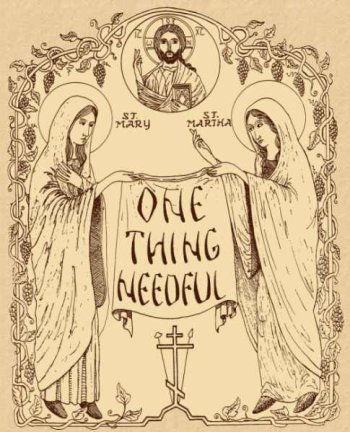
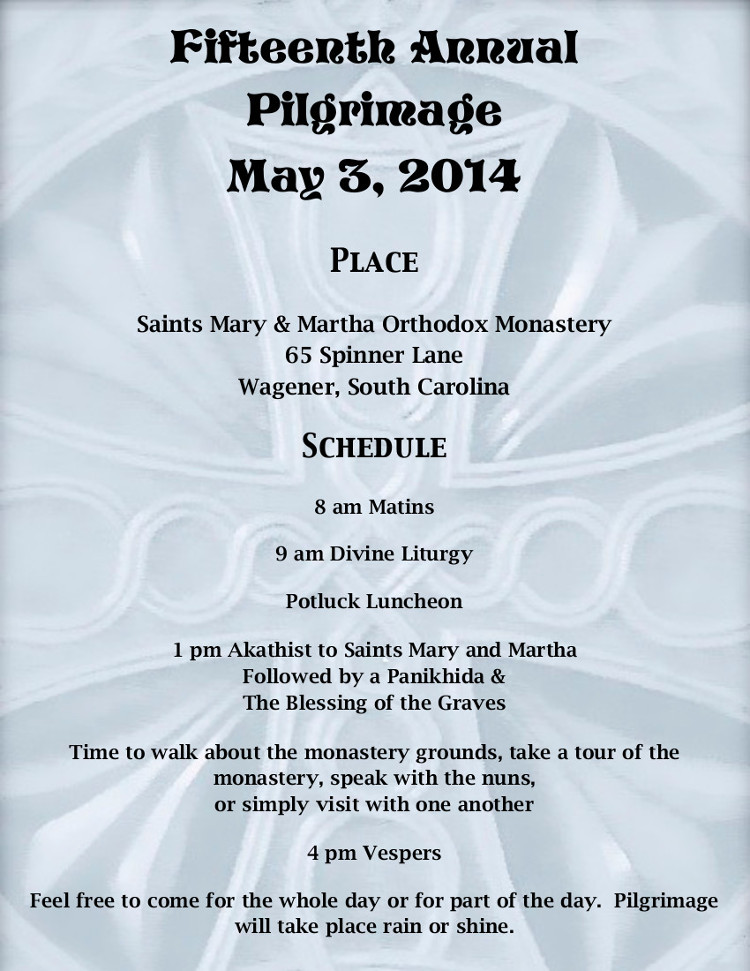
Submit yourselves therefore to God. Resist the devil,
and he will flee from you. — James 4:7
In contemplating and acting on this verse from the Epistle of Saint James, we find that we must vehemently will ourselves, even over our own protests, to surrender to the directing and in dwelling power of the Creator of Creation who gave us freewill to choose or reject Him. Each day, each moment, each movement, each thought, each word should be an act of willfully turning ourselves toward God. The evil one constantly prods us by persistently suggesting alternatives to God’s Way. Confusion, frustration, deception, and selfishness, to name but a few of Satan’s devices, are used to turn us in any direction that would lead us away from God. We must repeatedly refuse to be led away from the path that God is leading us.
As sinners we fall countless times. Always remember that God forgives us and helps us to rise up each time. Never despair. Never give up. Never quit striving to submit to God’s will.
Love begets love infinitely. With all the love God gives and teaches us, we discover that our falls help us to humble ourselves, to forgive others, to cease judging, and to form Christ-like habits in submitting to God in all ways. Little by little we become one with Him. If we persevere in this manner, the evil one, who knows better than we how truly omnipotent God is, cannot endure being in our presence and flees.

ONE THING NEEDFUL
WINTER 2014
MONASTERY NEWS
Today, Saturday March 1st, marks the Orthodox Church’s annual remembrance of all departed monastics, both monks and nuns. Last Saturday, February 22nd, marked the first year anniversary of Mother Lyubov’s passing. Both events gave us cause to stop and remember that Christ raises up people in each generation whose light shines forth showing us the importance of steadfast faithfulness to the directing of the Holy Spirit.
Everyone, especially those in construction have been waylaid by the winter weather this year. Here in South Carolina, the freezing temperatures, rain, a snow storm at the end of January, and an ice storm with power outages at the beginning of February have delayed progress on our building, not to mention keeping us Southerners out of the garden.
Nevertheless, there has been progress between the rain and freezes. The block & brick layers finished blocking in the sun room (which will also double as a sitting room or work room), built the two brick pillars for the outdoor stairwell on the east side, and completed the base for the altar to sit on. This base is the height of the raised floor for the altar and solea area.
 View from Inside the Sun Room
View from Inside the Sun Room Stairwell Pillars on East Side
Stairwell Pillars on East Side
The framers installed the floor trusses and laid down the sub-floor, installed the roof trusses, sheathed the roof, added waterproofing, and boarded up the window areas of the sun room. Once the brick pillars were built, the framers returned to brace these pillars and install the roof trusses, etc., of the exterior stairwell.
 View of West Side Showing the Base for the Onion Dome
View of West Side Showing the Base for the Onion Dome They also built the twelve-foot square base on the roof upon which the onion dome with cross will sit.
Some of you will notice the door above the second story, double door. It goes to the mechanical room for this section of the building.
The roofers have started installing the forest green, metal roof. If the weather holds, they should be finished by Thursday. However four days of rain are predicted for this week. Practicing patience is a good spiritual exercise, especially during Lent.
Three months ago, on December 6th, Linda Felicity Temple-Braxton, after a long illness, was buried here. May her memory be eternal.
Not only was December 6th Saint Nicholas Day, but the following day, a Saturday, was the Saint Nicholas Festival at Holy Apostles Orthodox Church in West Columbia. The festival was a success even though it was a drippy day. The three of us fought against the rain water blowing into our tent till about 3pm when we started packing up. All in all it was a good day as we raised over $600 for the building fund.
On Sunday afternoon, December 7th, we attended the Tree of Remembrance Service at Blizzard Funeral Home in Wagener. Most of the families who had lost love ones over the last year and to whom Wilson Blizzard had been of service attended. It was noteworthy to us that he had worked with three Orthodox families this past year. We are most grateful for Wilson Blizzard’s ministry to the bereaved.
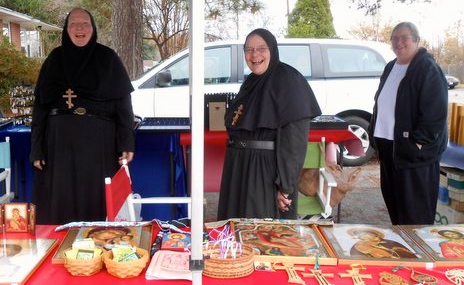
The rest of December with its celebration of the Nativity of Christ followed by the feastday of Saint Basil on January 1st and Theophany on January 6th ever so quickly came and went.
With joy we attended the marriage of Alexander Kautsky and Christina Perdomo, the daughter of Father Antonio and Elizabeth Perdomo who are long-time friends. But alas, we do not have a picture of us with them. We pray that God grant them many beautiful years together.
Another joyous event occurred on January 25th when we attended a Thanksgiving Service (The Akathist of Thanksgiving) followed by a banquet at Saint Mary Magdalene Orthodox Church in Rincon, Georgia, which celebrated 25 years as a parish. We have watch them struggle and grow over the years. It truly was with much thanksgiving that they reached this milestone in their history.
After the January snow melted and before the ice storm, we hosted the Knitters’ Retreat on February 7th and 8th. While eleven women signed up, eight actually attended. There are some very talented knitters in this group, but spinners are making inroads to this group as well. Waffles were served for Saturday morning breakfast which everyone enjoyed, especially with real whipped cream. Below are some pictures of this year’s knitters and spinners.
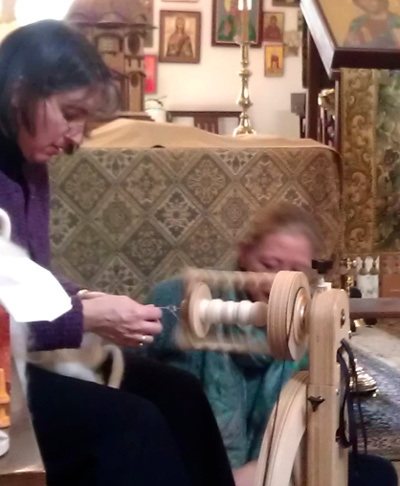
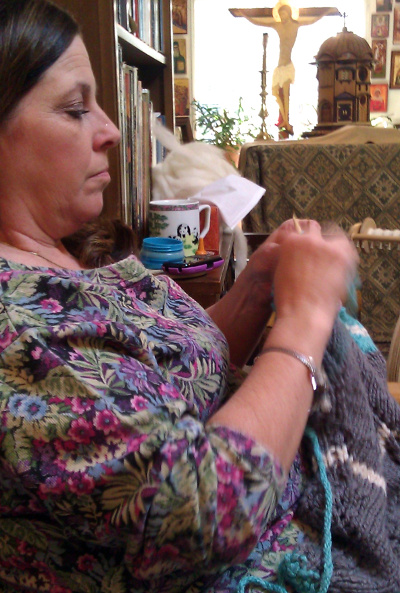
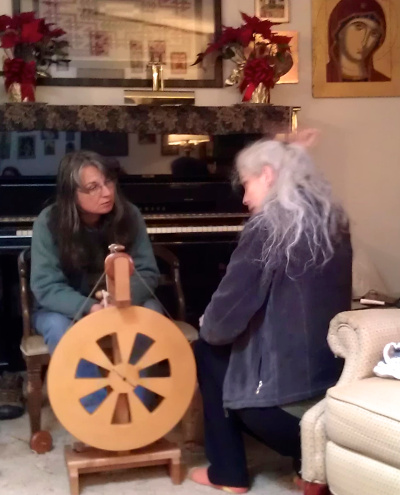
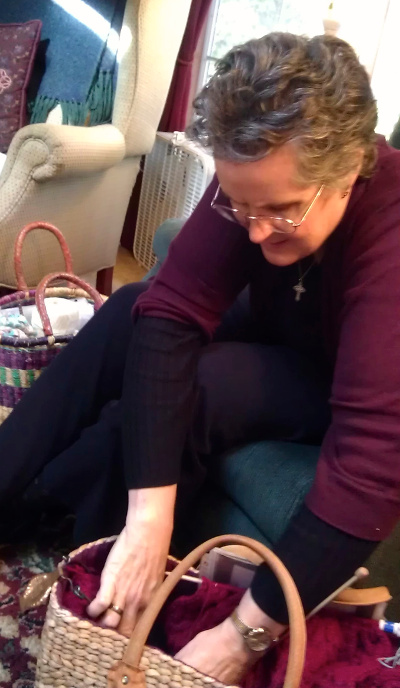
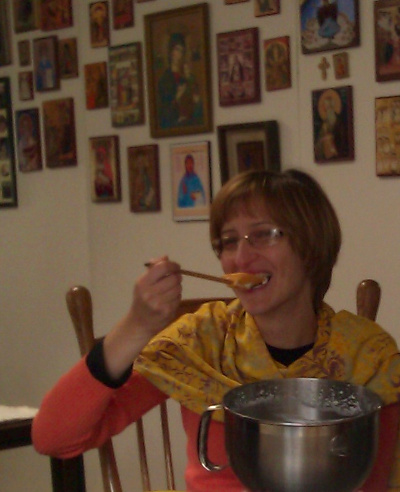
Sleet started falling the Tuesday night after the Knitters’ Retreat and continued for over 24 hours. It took out power lines, trees and tree limbs broke. We were without power for only two days. Many around us were without power for almost two weeks. It was so much worse north of us. Although we had a supply of kerosene, it was not enough, so on Thursday we were able to replenish our supply.
All day Thursday, Laufey, our ten year old sable and white collie dog was failing rapidly. She had been failing for some time, but age, sickness, and cold took her. Laufey was a good name for her as she was almost always bright and cheerful.
As if this wasn’t enough, the week ended with a 4.1 earthquake.
This winter the hawks thinned out our squirrel population for which we are grateful. However, we think they also took one of our ducks. Now we only have twelve ducks, but that will change when ducklings are born in May or June.
As always we are grateful for those who volunteer to help us with the many tasks needful to keep this monastery in good order.
With all the cold, it is past time to trim the orchard, bring in manure, plant cold weather vegetables and replace old asparagus plants, and a hosts of other garden chores. The picture of daffodils in our woods proclaims, “Spring cometh!”

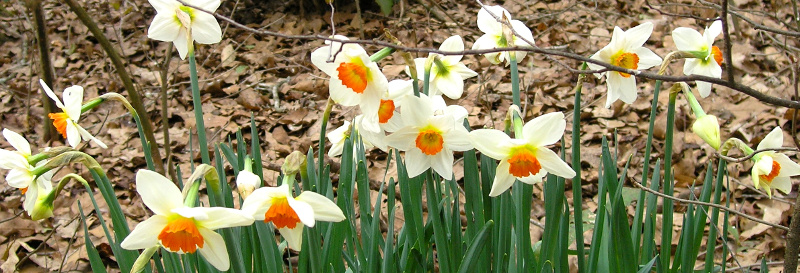

HOLY MOTHERS
OF THE KIEVAN CAVES
(continued)
Saint Juliana Olshanskaya
(September 28th/July 6th/October 10th)
On July 6th in the early part of the sixteen hundreds, during the time that Archimandrite Elisha Pletenets (1599-1624) was Abbot of the Kiev Perchersk Lavra - Caves Monastery, some monks were digging a grave in the cemetery near the Church of the Dormition when, unexpectedly, they came upon the coffin of a princess. On the lid, there appeared a plaque with the Olshansky coat-of-arms which bore the inscription “Juliana, Princess Olshanskaya, Daughter of Prince Yuri Dubrovitsky-Olshansky, reposed a virgin in the 16th year from her birth.” Upon opening the coffin, the monks found her clothing and body whole and incorrupt, as if she were alive and had just fallen asleep.
While nothing specifically is known of her life except her name, age, and that she was a virgin, the fact that her body and her clothing were found incorrupt after having been buried for over sixty years indicates that Juliana lived a holy and God-pleasing life. Her chaste life enabled her to intentionally partake of the salvific events of the divine-human life of Jesus Christ, thereby commingling with His divine and enduring beauty outside the dissonance of time. God choose to glorify her in this earthly manner.
Her incorrupt body was translated to the Church of the Dormition, but was mostly forgotten. After several years, Saint Juliana appeared in a dream to the Abbot, Archimandrite Peter Moghila (later Metropolitan of Kiev and Galicia from 1633-1646). She upbraided him for negligence and indifference shown to her relics. Whereupon, he arranged for a cloth covering to be embroidered by nuns, a new sarcophagus to be built with the inscription, “By the will of the Creator of heaven and earth Juliana, patroness and great intercessor to Heaven, rests here for all time. Here are the bones... healing against all passions... You adorn Paradise, Juliana, like a beautiful flower...”
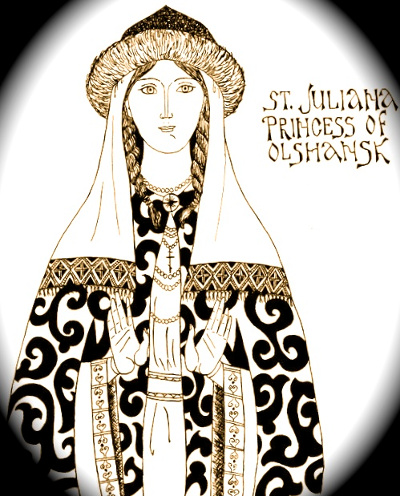
Many people started making pilgrimages to the Caves to venerate Juliana’s relics and to ask her to pray for them before the Throne of God. Through her intercessions numerous miracles occurred at the site of her relics. The Holy Princess Juliana continues to be a powerful intercessor for those in need. Her feast is commemorated on September 28th and the finding of her relics is celebrated on July 6th. She is also commemorated on October 10th with six other Saints of Volhynia (a region between Poland and the Ukraine).
In 1718 the Church of the Dormition burned. Juliana‘s holy relics were collected, placed in a reliquary and moved to one of the churches of the Near Caves.
The Synaxarion: The Lives of the Saints of the Orthodox Church Volume Six July, August, by Heiromonk Makarios of Simonos Petra, Translated by Mother Maria (Rule) and Mother Joanna (Burton), Holy Convent of the Annunciation of Our Lady, Ormylia, Greece, 2005, pgs. 64-65.
www.crkvenikalendar.com/zitije_en.php?pok=0&id=EED
Saint Dosithea the Recluse
(September 25th)
The third of our “Mothers of the Kievan Caves” was a great ascetic who contributed much to the revival of the Hesychast tradition of Russian monasticism. (Hesychasm is the practice of silence, peace, and quietness of the whole self through continuous prayer and asceticism, and thereby achieving transfiguration by becoming one with Christ through the Holy Spirit.) For years St. Dosithea was thought to be a man, “Dositheus the Hermit” or “Dositheus the Elder”. It was she who, foreseeing his holy future, blessed St. Seraphim of Sarov (Feastday January 2nd) to embrace monasticism and taught him to foster a watchful mind and heart by ceaseless recitation of the Jesus Prayer — “Lord, Jesus Christ, Son of God, have mercy upon me, a sinner.”
St. Dosithea was born into 18th century Russia at a time when monasticism was still reeling from the tremors of Peter the Great’s ecclesiastical and monastic “reforms”. He placed all church administration under the State, seized monastic properties, and decreed that monks engage in “useful” services. Monasteries, if they were allowed to remain open, were ordered to set up hospices, orphanages, schools, and even facilities for retired soldiers. He set age limits for those entering the monastic life and restricted the number of monks. Additionally, severe restrictions were placed on transfers from one monastery to another in an effort to limit the spread of monasticism. Peter the Great was extremely concerned about the falling birth rate and strongly encouraged women to marry and raise large families. He was particularly opposed to women taking vows of virginity and joining the ranks of monastics.
It was into this environment that Blessed Dosithea was born in 1721 to a noble family of the Riazan Province. In the world, she was known as Daria Tyapochkina. For much of her young life, she was cared for by her grandmother, Porphyria, a nun at the Monastery of the Ascension in the Kremlin. Mother Porphyria educated Dosithea, instilling in her a great love for God and the life of asceticism. Dosithea was forced to return home after Mother Porphyria took the Great Habit which, in the Russian tradition, meant she became a solitary monastic who practiced prayer and silence to the end of her days. Having taking a vow of virginity, Dosithea continued to live like a monastic after returning home. Secular life did not attract her. Hearing of her parents’ plans of marriage for her at fifteen years of age, she donned the attire of a young, peasant lad, fled to the Lavra of St. Sergius, and called herself “Dositheus”. Her “disguise” was not due to the modern explanation of some sort of sexual deviation or repression, but rather it served to enable her to remain faithful to the vow of virginity she had made, a vow that would help her to create an environment conducive to steadfast devotion of God with fewer distractions.
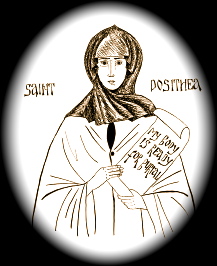
St. Dosithea was accepted as a novice at the Lavra and worked as a sacristan. After three years, she fled the Lavra in secret to avoid the persistent inquiries of her parents. Dosithea arrived at the Kievan Caves, but was not accepted since she did not have proper documentation as mandated by the Tsar. Having no other option and refusing to return to the world, she embraced the eremitic life and hid in a cave near the Skete of Kitayev Pustyn which was near the Kiev Perchersk Lavra - Caves Monastery. She lived in extreme poverty and monks in the area, amazed at her asceticism, would leave food and water for her outside the cave. Dosithea came to be known as “Dositheus the Hermit” and, although she was still young, she was sought out by the faithful for her spiritual insight. She would speak with visitors through a small window that obscured her face. In 1744, Dosithea was visited by the Empress Elizabeth Petrovna, the daughter of Peter the Great, who reigned from 1741-1761. The Empress “legalized” the hermit’s existence and gave permission for Dosithea to be tonsured a monk.
Shortly after this tonsuring, a young woman came to the Skete looking for the now known “Starets Dositheus”. She found the cave, and, knowing of the hermit’s gift of prophecy and clairvoyance, she asked him about her missing sister and expressed her longing to be reunited. Dosithea did not reveal her identity and simply replied that she should seek her sister no longer because she had gone into hiding to better serve the Lord. Dosithea never vacillated with regard to her particular form of life, no matter how tempting and difficult the set of circumstances. She was faithful to her vow of virginity and remained dead to the world, even when faced with blood kin.
When the eremitic life was forbidden in Russia by imperial decree, Blessed Dosithea, still disguised as “Dositheus the Hermit”, took refuge in the Far Caves of the Lavra of Kiev. Over time, the excessive number of visitors disturbed her solitude, and she eventually returned to Kitayev Pustyn, settling in a remote cell of the Skete. Being clairvoyant as well prophetic, Dosithea insisted that her cell attendant and disciple Theophan travel to Moldavia, the center of spiritual rebirth headed by St. Paisius Velichkovsky (Feastday November 15th) who was also a clairvoyant. Because of her insistence, he received outstanding spiritual training in the hesychast tradition there, which was almost non-existent in Russian monasteries in the 18th century.
Upon his return to Russia, Theophan remained with his “Elder” until her repose. Knowing that the time of her death was near, Dosithea visited the brothers of the Skete and spoke final words of rejoicing. She was found dead on her knees in front of an icon on the morning of September 26, 1776. In her hand she held a paper which said, “My body is ready for burial. I beg you not to touch it and to bury it in the usual way.” Only after her death was it discovered that “Dositheus the Hermit” was a woman. In obedience to his “elder”, Theophan left Kitayev to lead the eremitic life at the Monastery of Solovki (located on the Solovetsky Island in the White Sea in northern Russia) where he contributed to the revival of the Hesychast tradition which had fallen into disuse in Russia. Therefore, the prescient recluse, St. Dosithea, dedicated to a life of prayer, chastity, poverty, and solitude, was the “hidden” impetus leading to the transmission of the Paisian tradition to Russian monasticism.
Saint Seraphim Wonderworker of Sarov and His Spiritual Inheritance, by Helen Kontzevitch, Translated by St. Xenia Skete, St. Xenia Skete, Wildwood, California, 2004, pgs. 20-21.
The Synaxarion: The Lives of the Saints of the Orthodox Church Volume One September, October, by Heiromonk Makarios of Simonos Petra, Translated by Mother Maria (Rule) and Mother Joanna (Burton), Holy Convent of the Annunciation of Our Lady, Ormylia, Greece, 2005, pgs. 255-6.
The pin & ink icon
drawings were done by
Denise Babineau Norman.
http://svetilenstudios.blogspot.com
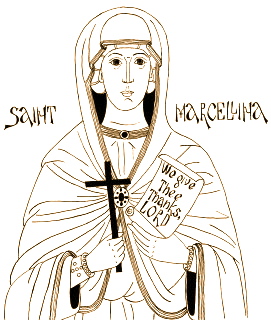

BUILDING FUND UPDATE
Between holidays, snow, ice, and, in general, freezing weather, progress has been slow these past three months. However, you can see by the pictures in the “Monastery News” section that progress was made by the grace of God.
Soon, the money that we have diligently saved for many years will be spent, but there is much to show for all of our efforts. When available, a list of things that need to be done on the building will be posted with dollar amounts. As we have the money, we will continue to build in God’s time.
Saints Mary & Martha Orthodox Monastery
65 Spinner Lane, Wagener, South Carolina 29164



Saturday Liturgy Schedule
April 5th at 9 am
May 3rd at 9 am
Pilgrimage
June 14st at 9 am
July 5st at 9 am
Matins starts at 8 am.

FROM MARTHA’S KITCHEN
MANDARIN VEGETABLE MEDLEY
1 pound asparagus spears, boil 1 minute, drain,
cut into 2 inch pieces
2 cups fresh snow peas
1 15 ounce can whole baby corn, drained
1 11 ounce can mandarin oranges, drained
1 8 ounce can sliced water chestnuts, drained
2 ribs celery, thinly sliced
½ cup red onion, finely chopped
1 scallion, finely sliced
Dressing
5 Tablespoons lemon juice
2 Tablespoons olive oil (or oil of choice)
2 teaspoons low sodium soy sauce
1 Tablespoon honey
1 teaspoon Dijon style mustard
2 cloves garlic, minced
1 teaspoon pepper
1/2 teaspoon salt
2 Tablespoon sesame seeds
In a separate bowl combine these dressing ingredients and whisk.
Pour dressing over vegetables and refrigerate for at least 1 hour prior to serving.
Makes 8 servings.








